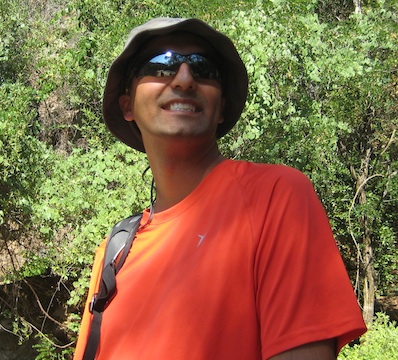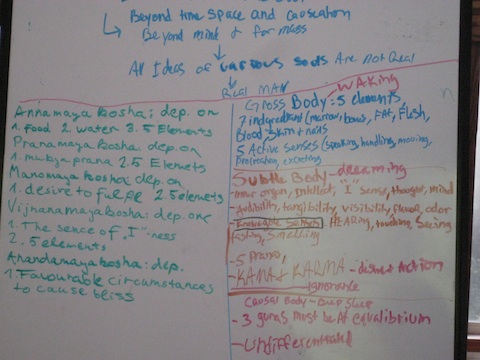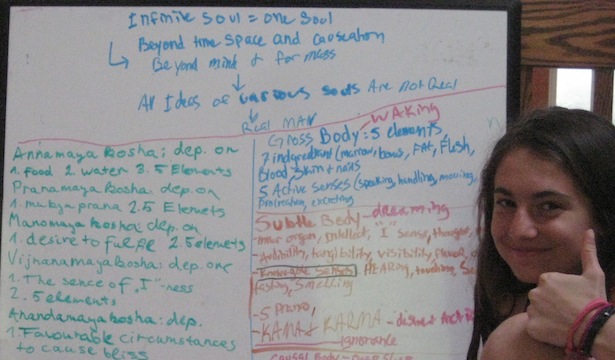Student Notebook
Article Index
Summer River Retreat 2013
by Mahesh Madhav
 This year's Chela Dharma class with the SRV youth concentrated on Jnana Yoga. Below is a description of some of the discussions that took place during our afternoons together.
This year's Chela Dharma class with the SRV youth concentrated on Jnana Yoga. Below is a description of some of the discussions that took place during our afternoons together.
As a starting point, we used chapter two of Swami Vivekananda's Jnana Yoga lectures. The students read the chapter and culled out some of their favorite parts, which we used to seed the discussions in class. The ultimate goal of Jnana Yoga is knowledge of the Self, or Atman. We seek this higher knowledge by fully comprehending that which is not the Self, and thus begins our study of the 24 cosmic principles of Sankhya, the 5 sheaths of the Adhara system, and the 3 Bodies.
The Gayatri Mantra starts off "Om Bhur Bhuvah Swah", immediately pointing out the three worlds of waking, dreaming, and deep sleep. We can directly identify these three worlds as the locations of our three bodies: the Gross Body (Stula Sharira), Subtle Body (Sukshma/Linga Sharira), and Causal Body (Karana Sharira). The students took upon themselves a mental exercise, where each time they made an "I" statement, they had to attribute it to one of the three bodies.
• "I hit my knee" – the gross body.
• "I am hungry" – subtle body.
• "I do not understand you" – subtle body.
• "I am one with God" – causal body.
We came up with an analogy to visualize the relationship between the three bodies. You can imagine a marionette hanging on strings. The body of the marionette that the audience can clearly see is the Gross Body. The clear strings that attach the marionette to the wooden handles are the Subtle Body. The wooden handles that are moving the strings up and down (by the hand of a marionette lord) are the Causal Body. We discussed reincarnation, and how our spool of karma, all retentive memory, and samskaras, are not stored in our Gross Body, since that body turns to ashes upon earthly death. Our karmas must therefore reside in the Subtle Body. Continuing with our puppet analogy, we can see how the clear strings attached to one marionette can be cut, and attached to a new marionette, which would then be beholden to the samskaras and past karmas that were being held in the strings of the Subtle Body.
As many of our students come from the Christian tradition, we often make allusions to the Christian teachings and put them in the light of Vedanta to provide a universal viewpoint. Here are some examples:
Vedanta does not have a concept of original sin. Man's soul is pure and perfect. The closest thing to original sin is the concept of "ignorance" and "ego." Through your ignorance of the divine nature of God, you decided to become separate from God. That is the ego, that you are separate. Everything else in the philosophy stems from there. With your ego, you take on the first sheath of separation. It is like filling a bottle with ocean water and dropping it in the ocean. There is water inside and outside, and it is the same water, but only separated by a thin layer of glass. Somehow through ego, you wanted this to happen and thus began the process of you taking a body. The next sheaths we discover are the sheaths of Intellect, Mind, Energy, and Physical Body, in that order. These are the coverings which hinder the realization of the Atman within, so we uncovered and unwrapped them one by one. We also took on the exercise of attributing our "I" statements to the five koshas.

On another topic, there are "five hells" in Vedanta, and they are ignorance, egoism, attachment to pleasure, aversion to pain, and clinging to life (fear of death). So hell is not a place, but rather the mindset that you are separate. Islam has a nice metaphor for hell; it is the dream state where you are brought closer to the purifying fire of God, which burns away your egoism and ignorance, and all your passions. It hurts like hell because it is you (your ego) which is being burned away. Once ego is gone, the pure Soul which remains is perfect and fit for communion with God. That makes a lot more sense than a cavernous area underground. And speaking of that pure Soul, a person's Soul cannot be purified by religious practice, or by going to church or temple, or by doing the rosary practice, or by taking a teacher, or learning all of scripture by heart….because the Soul is already perfect!
This is the teaching of the divinity of mankind. Each soul is potentially divine; the potential is there to realize it. Each soul is potentially Divine. The goal is to manifest this Divinity within by controlling nature, external and internal. Do this either by work, or worship, or meditation, or philosophy – by one, or more, or all of these – and be free. This is the whole of Religion — Swami Vivekananda. We must embark on a path in spiritual life and learn how to unwind our karma. We do this first by turning our minds towards God instead of away from God.
It is by God's grace that we think of God. Some people don't have any grace upon them; they are so far away from God that they don't even think of God by accident. But that is their current level in spiritual life. They are still excited by playing around with all the toys in the material world. And God is just fine with that! A mother will leave the child playing with its toys for as long as the child is interested in them. After a few hours the child will get bored of the toys and cry out for the mother. At that point the mother comes running and picks up the child. So, some of us are playing with toys. Some are starting to lose interest in toys. Some are crying out for God. Some are ready to be picked up, and others are already picked up and are telling others that they should give up their toys too. Your cries for the Divine Mother are being heard, and as you take a step towards Her, She is taking many steps towards you, to shower the needed Grace for spiritual pursuits.
Divine grace is there as a tenet of religion, but one cannot get by with grace alone. One must put forth one's self-effort. If we do not clean our house in the summertime, why would God want to come for a visit in the wintertime? Swami Aseshananda used to say that God's grace and self-effort are two wings of a bird. Another metaphor is, that our mind is a 10W light bulb. But to realize God we need a 1000W light bulb. If 1000W current goes through a 10W bulb, it will blow up. So we practice spirituality to expand the mind's capacity to know God and become the 1000W bulb. Swami Shivapadananda of the Ramakrishna Mission in South Africa has said "You attain liberation by God's grace, and also by your own worthiness. But remember that worthiness itself is God's grace. In other words, self-effort must never be given up. Self-effort must always be there. If your self-effort is there, even if you fail, it means you are still on the path of sadhana [spiritual practice]." So we are encouraged to do our spiritual disciplines (readings, meditations, selfless actions) even when we don't see results. The teacher can observe our development even though we cannot see it.
So, having a teacher is very important in making progress. Higher knowledge is transferred primarily in a 1:1 setting between teacher and disciple, and I have heard this explained in many religions, and even among musicians or dancers or other crafts which have formal apprenticeships. All of our other gatherings help shore up the spirit and make it worthy of uncovering knowledge, but a teacher/disciple relationship transcends the bounds of time. We say that it is the teacher that finds the disciple, not the other way around. And, as we have heard often, when the student is ready, the teacher will appear.
In the illumined soul, whom we must choose as our teacher, the concept of the Guru infills the physical manifestation of a true teacher. Even though you may think that your teacher is attended by imperfections, the Guru is nevertheless pure and perfect, and a direct pathway of divine wisdom transmission; it is your sight that is imperfect, not the Guru. As Holy Mother has stated, the Guru must be kept sacrosanct in your mind, for he represents your pathway to Satchidananda.
When we recognize that we need a teacher to make spiritual progress, how do we gear ourselves up so that the teacher will accept our request to be a disciple? The “application” we must fill out is the Sadhana-Chatushtaya, the Four Qualifications of the Aspirant. By learning and holding these qualifications, the student will be fit to receive the divine wisdom transmission of higher knowledge. In class we looked at the four treasures and six jewels inside out, and built a ladder down from faith. In Vedanta, we do not have blind faith, but rather a faith that is based on a foundation. Faith (Shraddha) in the divine and faith in oneself is based upon the ability to concentrate, single-pointedly, without distraction, on the one Reality. This ability to concentrate (Samadana) is possible because we have cultivated a forbearance of the dualities of the world including pleasure/pain, life/death, hot/cold. This forbearance (Titiksha) only comes to fruition because we have withdrawn our mind and senses from the sense-objects of the world, allowing us to be centered in the Self. This self-settledness (Uparati) has come about because we have practiced restraining the external sense organs. This self-control (Dama) has germinated from a practice of restraining the mind from seeking outward pleasures. This inner-peace (Sama) is possible due to our detachment from what is unreal, and identifying only with what is Real. The detachment (Vairagya) is possible only after we are able to discern the difference between the unreal and the Real. This discriminative ability is called Viveka. Thus, we have a ladder from discrimination all the way up to faith, built logically by the Sadhana-Chatushtaya. We then coat the steps of this ladder with the amber stain of Mumukshutvam, the sincere and intense longing for liberation. Our practices are always driven by this intense longing, and it is what keeps us going when the going gets tough.
On the final afternoon, the students went through several exercises in the lessons and presented them to their fellow students.



